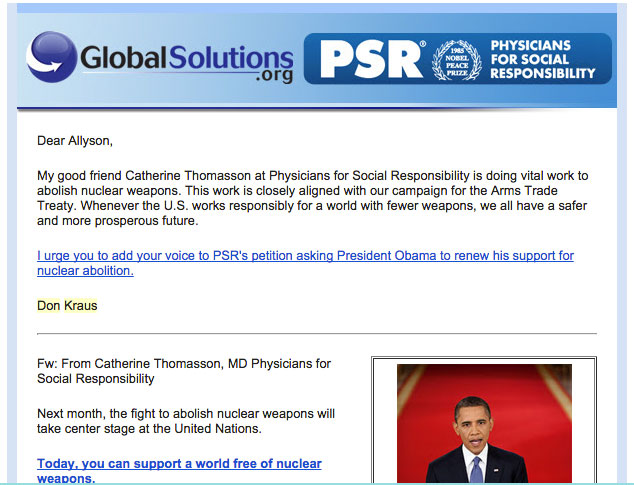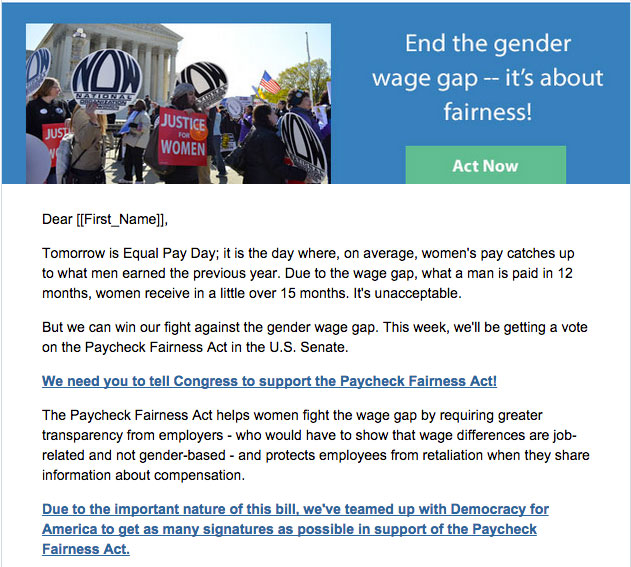Just about all Digital Strategists want bigger email lists: who wouldn’t want more supporters to talk to, mobilize and fundraise from? But list growth is expensive and hence sometimes out of reach for small nonprofits. Never fear, you can still find ways to grow your list that don’t cost money…only time!
A number of ways to grow your email list are available, but if I covered them all, this blog post would seem like a novel. So today, we’re going to focus on list swaps –- “trading” supporters with a like-minded organization.
Let’s start with the features of the two most common ways of doing a list swap. A critical aspect of both methods? They’re opt-in, meaning that the people taking action know whom they are taking action with and are consciously signing up for a new list.
Method 1: Separate Petitions
Each organization sends a different action request to its own list of supporters. However, each organization asks its supporters to engage in an action from the other organization. When individuals take the action, they join the list for the organization they were not previously associated with. Thus, each organization can expand its email list.
Method 2: The Joint Campaign
Each organization sends out the same action request to their email list, although the narrative in the emails can differ. In this joint campaign, any person who takes the desired action will now be a member of both organizations’ email list.
With Whom should You Swap?
Now that you know what a list swap is, how do you decide whom to swap with? When deciding whom to approach about a swap, think about your goals. Do you want to connect with a new group of people who are already linked to related organizations and who might be passionate about your core issue? Alternatively, are you a multi-issue organization seeking to build up a segment of your list that is concerned about a particular issue of the many that you aim to influence?
You should always chose a partner whose mission you agree with and support. Otherwise, the new group of supporters won’t be the right people for your organization. Thus, when I start brainstorming a list of potential partners, I think about organizations who work on similar issues and issue areas where my organization wants to grow. If you’re stuck for ideas you can also use Wisdom App, which analyzes your Facebook likes and gives you a list of other pages your community likes.
One consideration about whether to swap lists at all: if your hope is to expand your email list to allow your organization to more effectively address new issues or noncore issues, you’ll need to spend time and other resources to accomplish these ends. This can draw energy and attention away from your traditional activities, and is that trade-off worth it?
List Swap Logistics
With all that in mind, how do you actually pull off a list swap?
- First, reach out to potential partners.
- If one (or more) of your potential partners agrees to work with you, keep the celebration short, because it’s time to decide if you’ll be running a joint campaign or individual petitions.
- Now you need to create an agreement with them so that everyone is on the same page. The agreement should cover:
- Who is responsible for what components of the swap?
- How will you track signers from each organization?
- The best way to do this is through tagged links. When I do list swaps, I always make sure to have a separate tag for each organization as well as social media links for each organization. When the other organization is hosting the action, I always ask for three separate files: anyone who signed via my organizations link, signers who came in through social media, and the new signers from the other organization.
- How you will determine the number of names swapped?
- One way to do this is to agree to swap a number of signers within a range. This method is best for swaps with separate petitions.
- If you’re running a joint campaign and send everyone to the same action page then you can swap the exact number of new signers the smaller list is able to generate.
- You should also think about how you’ll handle new people who come in through social media or actions that where shared.
- Once you’ve worked out the agreement logistics, you can move on to developing a timeline. From my experience, it’s a good idea to give yourself more time that you think you need because both organizations have to approve the language for the emails and action.
- Send out the emails and watch the signers roll in!
- Swap the names based on your agreement
- It’s best to do this through excel files that can be uploaded to the CMS/CRM system that you use to send email blasts.
- Welcome your new members
How to Write the Email So People Know it’s a List Swap
It’s important for your list to know that this is a joint campaign or a petition from another organization. Otherwise, people might not know what they’re getting into!
If you’re sending out individual petitions, you can put an intro at the top of the emails that introduces the other organization and explains why their petition is a good idea. Here’s an example of what this would look like:

If you’re sending a joint petition, in the text of your email add a line about the organization you’re partnering with and why. Here’s an example of this method:

How to Welcome Your New Members
Every organization should have a general email welcome series (for more, check out this webinar by Care2 about welcome series) but your standard one may not be right for your new members.
A different welcome series is especially important if you’re doing a list swap on an issue that’s new for your organization or where you’re trying to increase your list interest. You need to make sure to connect the new issue to the issues your regular email program focuses on. This is also true for multi-issue organizations that mainly focus on one or two of their issues on email.
Your welcome series should introduce new members to your organization and explain the issues you work on (particularly if you’re a multi-issue organization and your new supporters came in via an action related to only part of your work). Then, give your new supporters ways to engage with your organization and explain why if they care about X issue they should care about the other issues you work on. This should help to increase their affinity for your organization and boost their engagement rates.
Analytics Analytics Analytics
Are your new supporters working for you? The only way to tell is to track their behavior, such as email open rates, click-through rates, response rates and the number who unsubscribe over time. You can then compare this data to your overall email program to help understand which issues your new supporters are connecting with and which ones they aren’t. It will also help you track your return on investment by determine if your new supporters are performing as well as you would hope. For more on list swap performance, check out this Epolitics.com article on the subject.
What NOT to Do
Growing your email list by buying a list from a company needs to be structured properly or else it’s a risky business. It’s fine if an organization sells you a list of people who signed a sponsored petition that you are running on their website (a la Care2 and Change.org), but buying a list that wasn’t obtained through a sponsored petition (or other opt-in mechanism) typically leads to low engagement rates from the purchased list.
This is because the people receiving your action requests are not connected to your organization and may not even be familiar with your nonprofit and mission. Moreover, people receiving these emails might mark them as spam. If enough people do this, some email delivery systems might designate any email from your organization as spam. This means that fewer of your supporters will receive your emails, which leads to less engagement. This also puts your organization at risk for collecting spam traps, which also harms your email deliverability. So be sure to start on the right foot –- only acquire supporters through opt-in channels like the ones discussed above.
Happy list swapping!
Originally posted on epolitics.com and cross-posted on Connectivity.



